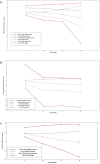Trajectories of Early Childhood Developmental Skills and Early Adolescent Psychotic Experiences: Findings from the ALSPAC UK Birth Cohort
- PMID: 29375433
- PMCID: PMC5767306
- DOI: 10.3389/fpsyg.2017.02314
Trajectories of Early Childhood Developmental Skills and Early Adolescent Psychotic Experiences: Findings from the ALSPAC UK Birth Cohort
Abstract
Objective: The aim of this study was to use prospective data from the Avon Longitudinal Study of Parents and Children (ALSPAC) to examine association between trajectories of early childhood developmental skills and psychotic experiences (PEs) in early adolescence. Method: This study examined data from n = 6790 children from the ALSPAC cohort who participated in a semi-structured interview to assess PEs at age 12. Child development was measured using parental report at 6, 18, 30, and 42 months of age using a questionnaire of items adapted from the Denver Developmental Screening Test - II. Latent class growth analysis was used to generate trajectories over time for measures of fine and gross motor development, social, and communication skills. Logistic regression was used to investigate associations between developmental trajectories in each of these early developmental domains and PEs at age 12. Results: The results provided evidence that decline rather than enduringly poor social (adjusted OR = 1.28, 95% CI = 1.10-1.92, p = 0.044) and communication skills (adjusted OR 1.12, 95% CI = 1.03-1.22, p = 0.010) is predictive of suspected or definite PEs in early adolescence, than those with stable and/or improving skills. Motor skills did not display the same pattern of association; although gender specific effects provided evidence that only declining pattern of fine motor skills was associated with suspected and definite PEs in males compared to females (interaction OR = 1.47, 95% CI = 1.09-1.97, p = 0.012). Conclusion: Findings suggest that decline rather than persistent impairment in social and communication skills were most predictive of PEs in early adolescence. Findings are discussed in terms of study's strengths, limitations, and clinical implications.
Keywords: ALSPAC birth cohort; adolescence; psychotic experiences; trajectories of early childhood development.
Figures
Similar articles
-
Child literacy and psychotic experiences in early adolescence: findings from the ALSPAC study.Schizophr Res. 2013 Apr;145(1-3):88-94. doi: 10.1016/j.schres.2012.12.025. Epub 2013 Feb 6. Schizophr Res. 2013. PMID: 23395451
-
A population-based study of atopic disorders and inflammatory markers in childhood before psychotic experiences in adolescence.Schizophr Res. 2014 Jan;152(1):139-45. doi: 10.1016/j.schres.2013.09.021. Epub 2013 Nov 22. Schizophr Res. 2014. PMID: 24268471 Free PMC article.
-
Association between common early-childhood infection and subsequent depressive symptoms and psychotic experiences in adolescence: a population-based longitudinal birth cohort study.Psychol Med. 2020 Nov 13;52(11):1-11. doi: 10.1017/S0033291720004080. Online ahead of print. Psychol Med. 2020. PMID: 33183379 Free PMC article.
-
The Avon Longitudinal Study of Parents and Children (ALSPAC) birth cohort as a resource for studying psychopathology in childhood and adolescence: a summary of findings for depression and psychosis.Soc Psychiatry Psychiatr Epidemiol. 2015 Jul;50(7):1017-27. doi: 10.1007/s00127-015-1072-8. Epub 2015 May 23. Soc Psychiatry Psychiatr Epidemiol. 2015. PMID: 26002411 Review.
-
Social-Emotional Functioning and Quality of Life in Language Disorders: A Systematic Review of Development From Childhood to Adolescence.Int J Lang Commun Disord. 2025 May-Jun;60(3):e70039. doi: 10.1111/1460-6984.70039. Int J Lang Commun Disord. 2025. PMID: 40260753 Free PMC article. Review.
Cited by
-
What's the impact of voice-hearing experiences on the social relating of young people: A comparison between help-seeking young people who did and did not hear voices.PLoS One. 2023 Sep 26;18(9):e0290641. doi: 10.1371/journal.pone.0290641. eCollection 2023. PLoS One. 2023. PMID: 37751433 Free PMC article.
-
Population genetics: past, present, and future.Hum Genet. 2021 Feb;140(2):231-240. doi: 10.1007/s00439-020-02208-5. Epub 2020 Jul 18. Hum Genet. 2021. PMID: 32683493 Free PMC article. Review.
-
Prevalence and recurrence of pica behaviors in early childhood within the ALSPAC birth cohort.Int J Eat Disord. 2024 Feb;57(2):400-409. doi: 10.1002/eat.24111. Epub 2023 Dec 14. Int J Eat Disord. 2024. PMID: 38097525 Free PMC article.
-
Combined pattern of childhood psycho-behavioral characteristics in patients with schizophrenia: a retrospective study in Japan.BMC Psychiatry. 2021 Jan 26;21(1):57. doi: 10.1186/s12888-021-03049-w. BMC Psychiatry. 2021. PMID: 33499818 Free PMC article.
References
-
- Cannon M., Caspi A., Moffitt T. E., Harrington H., Taylor A., Murray R. M., et al. (2002). Evidence for early-childhood, pan-developmental impairment specific to schizophreniform disorder: results from a longitudinal birth cohort. Arch. Gen. Psychiatry 59 449–456. 10.1001/archpsyc.59.5.449 - DOI - PubMed
Grants and funding
LinkOut - more resources
Full Text Sources
Other Literature Sources


